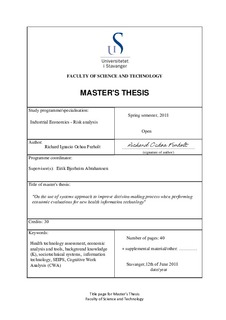On the use of systems approach to improve decision-making process when performing economic evaluations for new health information technology
Master thesis
Permanent lenke
http://hdl.handle.net/11250/2566087Utgivelsesdato
2018-06-12Metadata
Vis full innførselSamlinger
- Studentoppgaver (TN-ISØP) [1459]
Sammendrag
Economic evaluations comprise comparative analyses of different alternatives in terms of their costs and consequences, and is used as a basis for making prioritizations and decisions. When deciding on whether to provide a healthcare intervention, the primary concern is the extent to which it improves health outcomes, entailing quality of care and patient safety. The rapid development of information technology systems deployed in healthcare introduces changes; that will positively or negatively affect the work and clinical processes and the consequent patient, employee and organizational outcomes.
In general, economic evaluations performed for health technology assessments (HTAs) are conditional to the available information in the form of e.g. historical data, system performance and knowledge of the phenomena in question; defined as the background knowledge (K).
Economic analyses may oversimplify complex decisions in healthcare contexts, often ignoring important health and economic consequences, contextual elements, interactions or other relevant modifying factors. Hence, the importance of obtaining and identifying relevant knowledge elements that may influence the outcome of the economic evaluation. System interactions among people, tasks, tools and technologies, physical environment, and organization should be considered to understand the impact of introducing new health technology.
The objective of this thesis has been to contribute to the approaches that can be employed to inform decision-making in a healthcare context, more specifically to the proposed expanded approach by Sørskår et.al. for economic evaluation of new health technology. A discussion on the suggested framework has been performed using a real-world example, aiming to detect possible limitations and consider adjustments. In this way, the applicability of the framework in being a useful evaluation tool has been examined.
Health information technology systems serve, as a tool, medical personnel throughout the clinical and patient care work constituting a human-automation interaction. These systems are seen as significant means of improving healthcare quality and patient safety, as well as being beneficial for the general productivity and performance.
This study also explores a supplementary method to the socio-technical systems approach incorporated in Sørskår et.al. conceptual study; with the aim to conceive human-automation interaction in the context of system’s adaptation and self-organization. The examined framework stresses the importance of system adaptability to cope with unanticipated situations and challenges posed by the environment in which HIT systems are set in use.
In summary, the structure of this report is as follows. Chapter 1 presents the background, problem formulation and objectives of this thesis. Chapter 2 presents economic evaluation approaches that may be applied for HTA, and further discuss challenges in the use of the analysis tools. In Chapter 3, the conceptual methodology to assess K proposed by Sørskår et.al is presented, followed by an example using part of the methodology. In Chapter 4, the applicability of the suggested framework is discussed. In Chapter 5, a similar systems approach to improve the methodology is explored. Finally, in Chapter 6 some conclusions are drawn.
Beskrivelse
Master's thesis in Industrial economics
